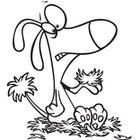Why pets shed and how to control it
Posted on
Cats and Dogs have 3 types of hair and they are:
Primary Hairs – Long and Course
Secondary Hairs – Soft and Fluffy
Tactile Hairs – Like Whiskers
It is mainly secondary hairs that are more prone to shed and usually it is the dead or damaged hairs that are the main contributors to the amount and frequency of a pet shedding.
Most of our pets shed hair but often it is seen as the longer hair breeds to be the most in need of grooming after and during shedding but this is often the illusion due to the length of hair.
There are a number of breeds that shed very little and some of these are Terriers, Hungarian Vizsla, Shar Pei, Airedale, Portuguese Water Dog, Bullmastif and Poodle to name a few. Short haired breed cats are also less likely to develop matted hair but shedding can still be prevalent.
Seasonal changes also contribute as the winter growth dies off leaving a trail of dead hair shedding from our pets. Grooming early and consistently is key to stopping hair from matting. Inside pets are less likely to shed as much or as often due to their controlled environment around temperature.
Their is also a risk of your pets shedding during pregnancy as their unborn or new born rely on mothers nutrients and minerals for growth and health. Taking many key elements from the mother will deplete her ability in maintaining her skin and coat. This should be followed up by a visit to the vet to put a plan in place to provide the mother or mother to be with the essential vitamins and minerals so they can maintain their health along with their coat and skin.
If your pet continues to shed out of seasonal changes and their coat and skin look dull. It is also imperative to have a vet consult to alleviate any underlying illness issues that may be causing poor skin and/or coat.

